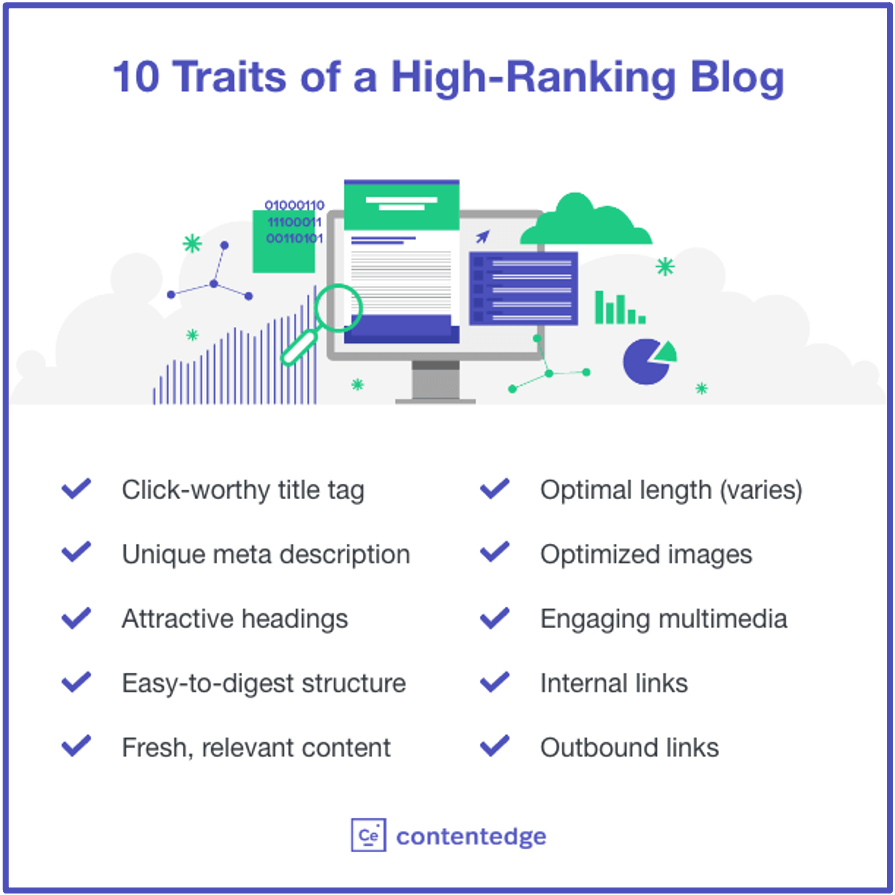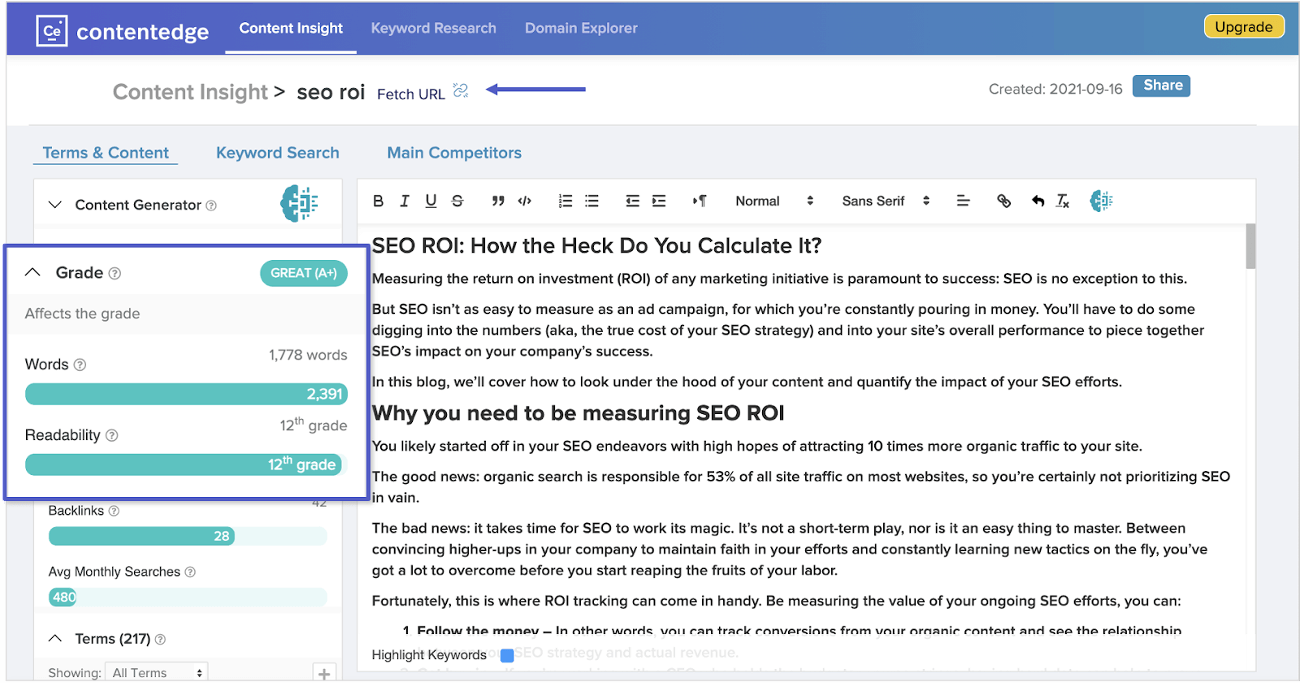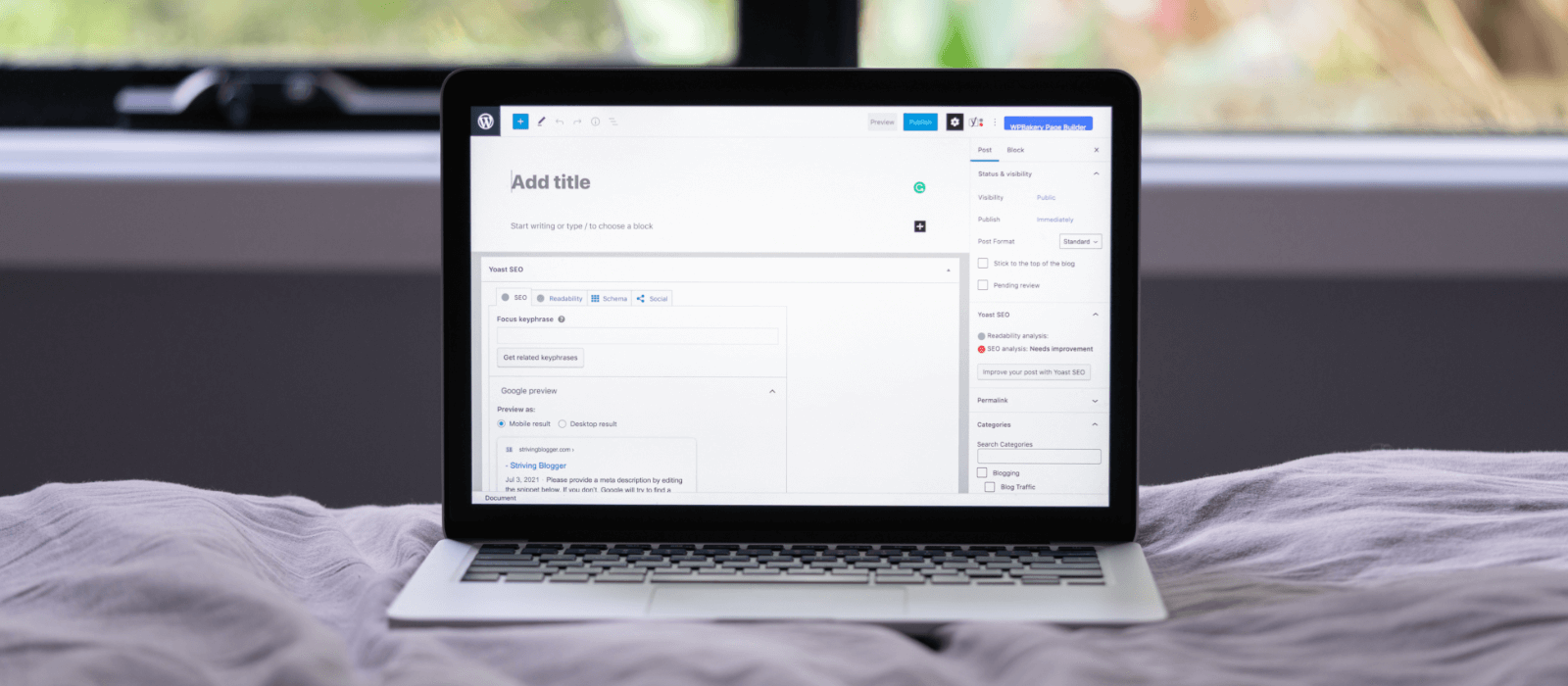Blogging is often trickier than it sounds.
Unfortunately, it’s not enough to be a good writer. To excel in SEO content writing, you need to have a good grasp of how Google works and what factors it considers when ranking your pages.
While Google looks at over 200 ranking factors, several factors are influenced by the way you write, structure, and format your blog. In this blog, we’ll cover those core factors and tips for optimizing your blogs.
How does SEO writing differ from normal writing?
SEO writing, first and foremost, is an art in itself. While it certainly helps to be a good writer, there are specific SEO practices to keep in mind as you write for both humans and Google’s web crawler.
As mentioned earlier, Google looks at a ton of different characteristics about your webpage to determine whether it’s legit, relevant, and deserving of a top position on its SERPs. So in addition to having good prose and proper grammar, you’ll need to know how to speak Google’s language.
SEO writing, in a nutshell, is a blend of good writing and specific efforts towards proving your topical authority to Google.
10 traits of a high-ranking blog

1. Click-worthy title tag
The title tag of your blog isn’t all too different from the headline of a Google ad. Both are the first lines of copy that a user may see when stumbling across your page on a SERP. Both should ideally include your primary keyword (or a close variation of it) and be enticing to your target reader.
Similar to how Google scores the relevancy of your ad copy, you’ll also want to ensure that your title accurately represents what a user is about to read. A click-worthy title is not to be confused with clickbait. In fact, Google will take notice if bounce rates are high and suppress pages that appear to be low-quality or irrelevant to searches.
Note that even though it’s best practice to customize your title tags, Google reserves the right to rewrite your title tag. The search engine has been spotted using everything from H1 copy to anchor text to auto-generate its own title if yours is too long (the sweet spot is 50-60 characters), keyword-stuffed, obscure, or incomplete. However, Google claims that it still uses title tags 87% of the time, underscoring the importance of providing your own titles.
2. Unique meta description
If title tags are like Google ad headlines, meta descriptions are like your main ad copy. They serve to provide a bit more detail upfront and invite people to visit your page.
Like title tags, meta descriptions are at the mercy of Google’s discretion. Even so, it’s worthwhile to customize your own descriptions in the event that it gets selected. This ensures that your page is accurately represented on SERPs.
Meta descriptions should be 160 characters or less, include your primary keyword, and be unique to every page. Remember to align it with your blog content to avoid bounce-offs or low-quality clicks.
3. Attractive headings
If you’ve been around SEO for a while, then you’ve likely been told that your heading must include your keyword, and that an H1 tag is more important than an H2 tag. Such might have been the case in the early 2000s—but today, that isn’t necessarily the case.
Google’s John Mueller debunked both myths, indicating that both are “rote” SEO habits. Google doesn’t necessarily care which types of headers you use but will look at them to distinguish sub-topics from the main topic. Furthermore, keywords aren’t required in heading tags. Rather, Google uses heading tags to better understand the content underneath them.
For this reason, you’ll want to make sure that your headings are well-organized and offer a positive reading experience. Your headings ultimately exist to help readers and web crawlers easily find the information that they’re looking for.
4. Easy-to-digest structure
All in all, how a reader perceives and digests your content has a big impact on engagement levels (which, in turn, impacts your chances of ranking).
Think about the last time you clicked onto a site. What did you see? If you saw a huge wall of lifeless text, then I’m willing to bet that you exited the page as quickly as you entered it. On the contrary, if you were met with an attractive header image, easy-to-read headings, and bulleted lists to break up the text—then you probably lingered for a little while longer.
Keep this in mind as you format your own blogs. Don’t underestimate the importance of clearly structured content that guides readers down the page and keeps them engaged.
5. Fresh, relevant content
When it comes to the “meat” of your blog—your body paragraphs—make sure that you’re providing unique, up-to-date insights. Don’t take shortcuts, such as mimicking the content found on other pages that rank for your keyword.
This not only bores readers and hurts your ability to become a thought leader, but also inhibits your ability to rank. Google is getting smarter every day and uses AI, including NLP, to serve up results that readers will be excited about.
To that end, you’ll want to focus on producing relevant content. Write about topics that you’re an expert in and analyze the search intent behind your target keywords. Speak in the same language as your readers, incorporating semantically related keywords wherever appropriate.
Pro tip: If you’re in a creative rut or need a nudge in the right direction, ContentEdge’s AI-powered Content Insight tool can autogenerate copy to get you started. It can alternatively fetch a list of words that are frequently used with your keyword, plus gauge the appropriate readability level for your topic.
6. Optimal length
Google generally favors longer posts because length tends to be indicative of the amount of helpful information on a page. That said, there’s no magic word count to strive after (though many will ballpark 2,000 words or higher). The optimal length for your content will vary by keyword or topic.
For instance, for transactional keywords like “women’s running shoes,” Google is not going to expect an exhaustive, text-laden webpage. But for an informational search like “how does AI work in SEO,” you would expect a much meatier blog.
For more specific guidance, you can use ContentEdge’s Content Insights report to view the average length of a high-ranking page for a keyword. As you aim to flesh out blogs appropriately, make sure to keep formatting in mind. It’s usually a good idea to break up text into more bite-sized paragraphs, sentences, and bullet points.

7. Optimized images
Images are incredibly useful for sprucing up your page and/or illustrating important points. But images are one of the biggest culprits of slow load times. If your page is weighed down too much by your images, then you could easily lose your page rank to a faster loading page.
Use sites like TinyPNG to compress your image files without diluting its quality. You’ll also want to follow other image SEO best practices, such as using the best image format, a descriptive file name, and alt text. The latter enhances the accessibility of your page while helping crawlers to understand what your media is showing.
8. Other multimedia
Aside from images, it’s a good idea to include videos, social media embeds, infographics, and other multimedia that enriches the user experience. While none of these have a direct impact on SEO, they do have an indirect effect: they are likely to increase engagement on your site.
Readers are more likely to stick around for longer and share your posts with their network. This means greater visibility, more backlinks, and longer dwell time on your page. These are all off-page factors that Google takes into consideration when evaluating your site. The more satisfied your readers are, the more satisfied Google is too.
9. Internal links
Before you hit publish, take a moment to look for opportunities where you can link to another blog or page on your site. These links should send readers to more contextual (or supplementary) pages.
Google’s crawlers will similarly follow these links to discover content across your site. Google likes to see that you have multiple pages that are all related—this shows that you have topical authority—as it goes through the process of ranking your page.
This is the same logic by which content marketers and SEOs base their pillar page strategies. Pillar pages are essentially overview pages that link out to more in-depth articles on your site. If one or several of those articles perform well organically, then the expectation is that all other ships will rise.
10. Outbound links
Don’t simply limit yourself to internal links. Include links to other authoritative sites. For instance, if you mention a stat, quote a source, or introduce a novel idea that was first posted by someone else, include a link.
While you may balk at the idea of sending people away from your site, outbound links help to build trust in your content.
“All other things being equal, a page linking out to related content could reasonably be expected to perform better than one with no external links,” says one source. “In the grand scheme of SEO tactics, outbound links by themselves will not move mountains the way inbound link-building might, for example…[but] it may be that the effects of linking to external sites, like building trust, are what ultimately affect SEO for the better.”
Another secondary benefit: linking to a site can help to initiate a relationship with site owners, who may offer to link out to your site in return.
A final word
SEO content writing can feel, at times, more difficult than free writing. At the same time, it helps that there are some clear guidelines for getting your blogs in tip-top shape.
Heed the tips above to maximize your chances of ranking. And if you need help, drop us a note or try out ContentEdge for free.
